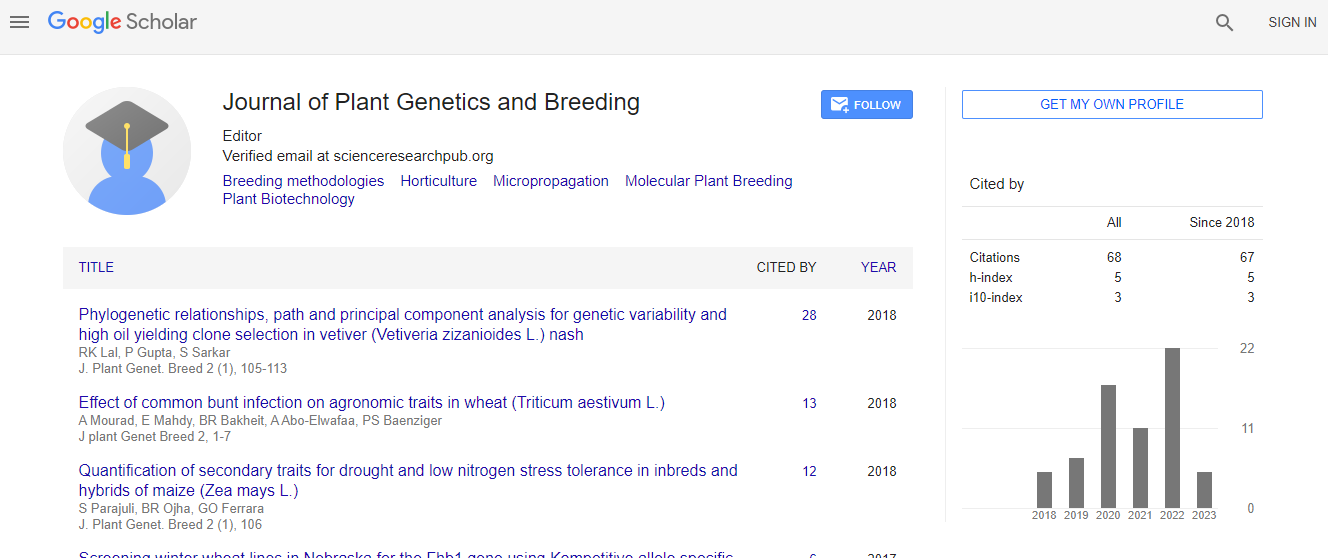Plant Science 2019: A Survey of Plant-Parasitic Nematodes Associated with Wheat Crops in South Africa- Siphamandla Lamula, North-West University, South Africa
*Corresponding Author:
Copyright: © 2020 . This is an open-access article distributed under the terms of the Creative Commons Attribution License, which permits unrestricted use, distribution, and reproduction in any medium, provided the original author and source are credited.
Abstract
Grain farming in Africa, especial in Sub-Saharan Africa is facing the combined effects of abiotic (including drought and poor crop management technology) and biotic (fungal diseases and pests) stresses. Among these, the cereal cyst nematodes (CCNs) (Heterodera spp.), root-knot nematodes (RKN) (Meloidogyne spp.) and root-lesion nematodes (RLN) (Pratylenchus spp.) are the main limiting factor for grain production and are considered as economically important for wheat worldwide and major facilitators of fungal infections such as fusarium species. Loses of cereals as a results of plantparasitic nematodes (PPNs) are estimated up to 6.9 to 50% ($US 125 billions) worldwide. The damage caused by these PPNs, their behaviour and control have received little attention in many African countries, especially Sub-Saharan African, in spite of indications by other countries that productivity of grains can be severely reduced. Aim: The aim of the current study is to identify the plant-parasitic nematode assemblages that occur in South African wheat producing areas with emphasis on morphological and molecular identification. Findings: A total of 776 composite rhizosphere soil and root samples have been collected from 24 localities over two seasons in the Free State (4), KwaZulu-Natal (1), Northern Cape (6) and Western Cape (13) provinces. Nematodes were extracted from soil and root samples by using the adapted decanting and sieving method, followed by an adapted sugar centrifugal method. Nematodes were extracted from kernels by means of soaking the samples in water for 24 hours and decanting the extract through a 20μm sieve. Nematodes species were identified on the basis of morphometrics and morphological fea
tures, while Prominence Values (PV) was calculated for each genus or family. Individuals from the following genera/families/orders were identified from the following provinces: Free State: Pratylenchus, Rotylenchus, Scutellonema, Helicotylenchus, Criconema and Dolichodorus; KwaZulu-Natal: Melodogyne, Pratylenchus, Criconema, Spiral and Longidorus; Northern Cape: Pratylenchus, Criconema and Spiral; Western Cape: Pratylenchus, Rotylenchus, Scutellonema, Helicotylenchus, Coslenchus, Tylenchus and Xiphinema. The predominant genera identified across the localities to date according to PV-value are Pratylenchus, Meloidogyne, Spiral, Coslenchus, Tylenchus, Criconema, Longidorus and Xiphinema. Cedara in KwaZulu-Natal had a high number of Meloidogyne (420 second-stage juveniles /200 g soil) compared to the other sampled localities. Western Cape (Malmesbury) showed a high number of Pratylenchus sp. (8750/200 g soil). In root samples, the PV of Meloidogyne in Cedara was 183 followed by De Vlei (PV=943), Tygerhoek (PV=490), Kopporfontein (PV=134) and Wellington (PV=57) for Pratylenchus sp. No plantparasitic nematodes were found in kernel samples. However, a bacterivore species of Panagrolaimus was identified from wheat kernels from Clarens in the Free State, being a first record both in South Africa and worldwide. The D2-D3, 18S rRNA, ITS, PCR and SCAR-PCR for amplification of detected genera is ongoing and thus far, among other economical important, species such as Pratylenchus thornei Pratylenchus neglectus and Pratylenchus bolivian have been amplified and the data corresponds with that of morphological and morphometrical identifications. Due to their microscopic size, nematode pests are commonly overlooked or misdiagnosed.
Note : This work was partially presented at World Congress on Plant Pathology & Plant Biotechnology scheduled during September 24-25, 2018 in Dallas, USA

 Spanish
Spanish  Chinese
Chinese  Russian
Russian  German
German  French
French  Japanese
Japanese  Portuguese
Portuguese  Hindi
Hindi 